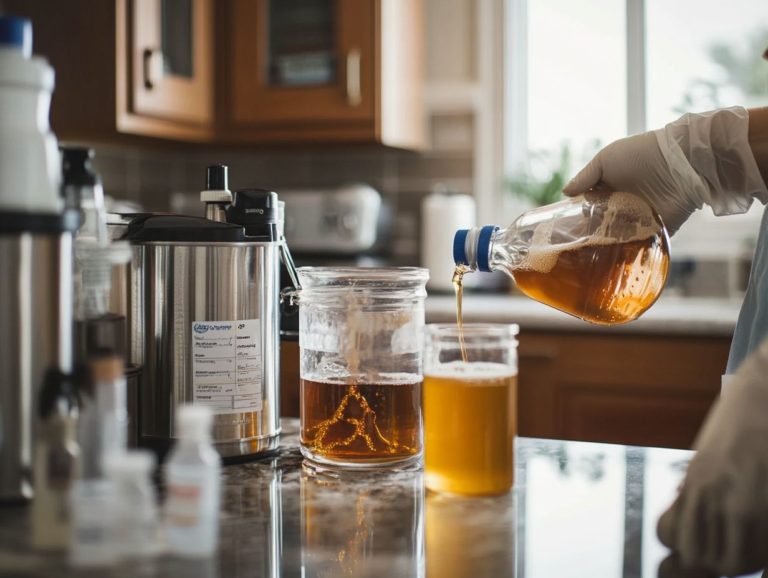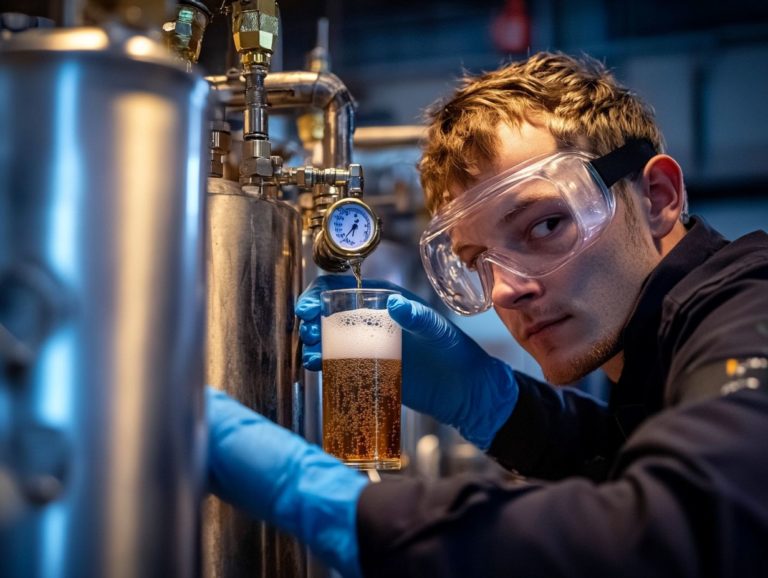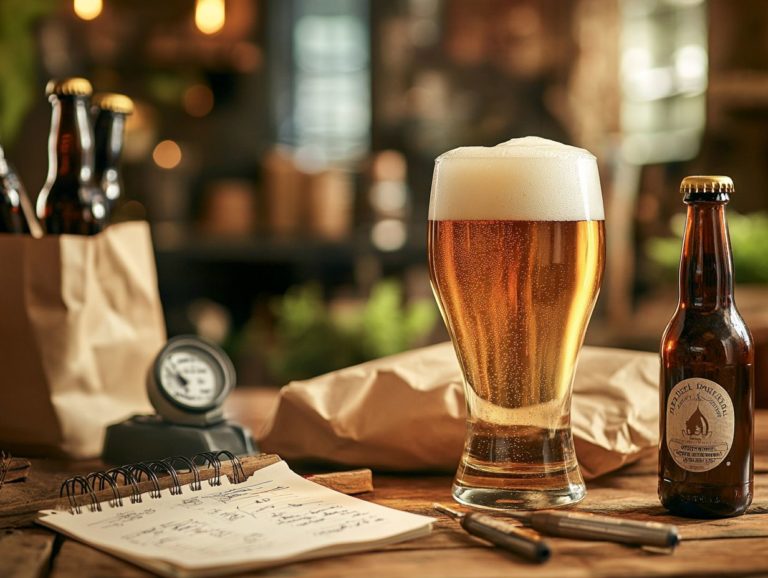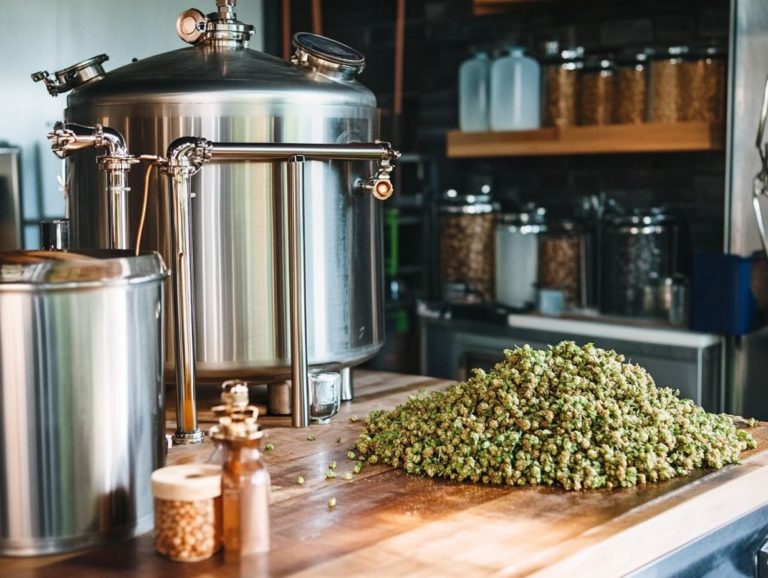How to Troubleshoot Home Brewing Equipment
Home brewing can be a truly rewarding and enjoyable hobby, but it doesn’t come without its challenges. As you dive into this craft, you may encounter common issues with your brewing equipment, such as poor water chemistry or fermentation issues, which can lead to less-than-stellar results.
From improper sanitation to temperature control challenges and managing mash thickness, these obstacles can certainly test your patience.
Troubleshooting is your secret weapon for brewing success! This article will walk you through the most frequent problems you might face, providing effective tips for addressing common mistakes and preventative measures to ensure a smoother brewing experience.
Whether you re a seasoned brewer or just stepping into this world, you ll discover valuable insights on how to manage pH levels, grain bed, and yeast nutrients to elevate your craft.
Contents
- Key Takeaways:
- Common Issues with Home Brewing Equipment and Brewing Process
- Troubleshooting Tips for Home Brewing Equipment
- 1. Properly Sanitize Equipment
- 2. Monitor and Control Temperature
- 3. Use High-Quality Ingredients
- 4. Check for Leaks or Clogs
- How to Prevent Issues with Home Brewing Equipment
- Frequently Asked Questions
- How do I troubleshoot my home brewing equipment if it’s not working?
- Why is my home brewing equipment not heating up?
- What should I do if my home brewing equipment is leaking?
- Why is my brew not fermenting properly?
- What should I do if my brew has an off-flavor?
- How can I prevent common issues with my home brewing equipment?
Key Takeaways:
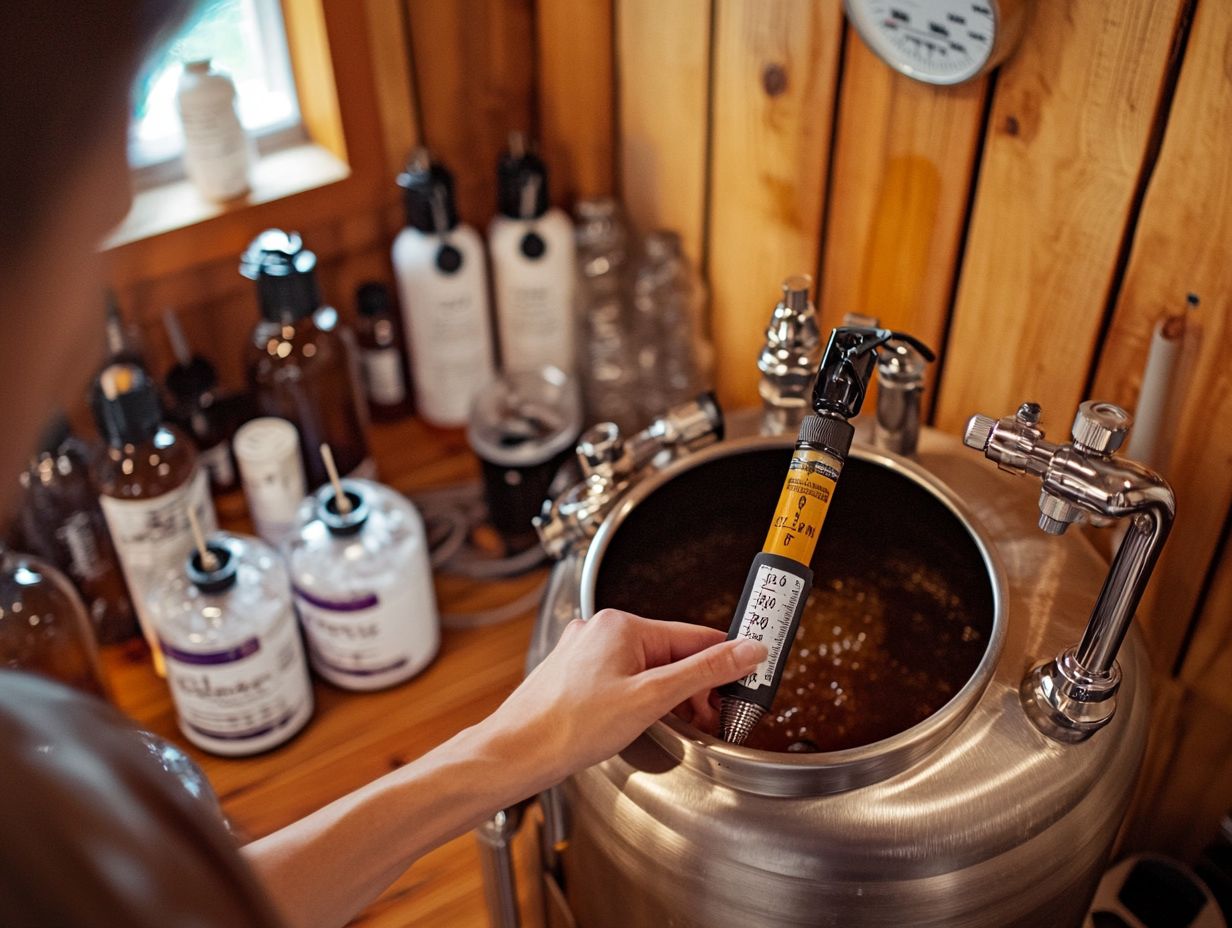
- Proper sanitation is crucial for successful home brewing. Make sure to thoroughly clean all equipment to prevent contamination.
- Consistent temperature control is essential for achieving the desired flavor and alcohol content. Use a thermometer and monitor the fermentation temperature closely.
- Investing in high-quality ingredients, including malt extract and hop varieties, can greatly impact the taste and overall success of your brew. Don’t skimp on quality for cost.
Common Issues with Home Brewing Equipment and Brewing Process
Homebrewing is an exhilarating hobby, but it certainly presents its share of challenges, particularly regarding brewing equipment. You may find yourself facing common hurdles that can impede your brewing success, including inadequate sanitation practices, fluctuating fermentation temperatures, inconsistent brewing ratios, and the temptation to use subpar ingredients.
Leaks or clogs in your brewing equipment can also cause significant setbacks, impacting everything from the density of your brew to carbonation levels. Grasping these issues is essential for attaining the clarity and flavor profiles you desire in your homebrew masterpieces.
Understanding brewing guidelines and carbonation methods can help you manage these issues effectively.
1. Equipment Not Sanitized Properly
One of the most critical mistakes you can make in homebrewing is neglecting to properly sanitize your brewing equipment. This oversight opens the door to harmful bacteria, which can compromise yeast performance and your entire batch.
Failing to sanitize can lead to off-flavors, such as DMS and diacetyl, and undesirable aromas, ultimately ruining your hard work. The importance of effective sanitization cannot be overstated; it ensures that every fermenter, bottle, and utensil is free from contaminants.
Popular methods include using solutions like Star San or iodophor both are highly effective and remarkably easy to use. While hot water can help eliminate residual impurities, it s the right sanitizer that provides the essential layer of protection against spoilage organisms. Always ensure you follow proper bottling techniques to avoid contamination.
For those who take their brewing seriously, recognizing that clean equipment directly impacts fermentation and overall beer quality is crucial. It can be the deciding factor between an average brew and a truly exceptional one.
2. Inconsistent Temperature Control
Inconsistent temperature control during fermentation can create a myriad of challenges, including stalled fermentation, harsh bitterness, and undesirable flavors in your final product.
The fermentation process relies heavily on maintaining a stable environment, as yeast thrives within specific temperature ranges. When temperatures fluctuate, yeast can either slow down or ramp up excessively, leading to off-flavors like fusels and esters that detract from your beer’s intended taste profile. Such temperature variances can also result in unwanted byproducts that alter mouthfeel or create an imbalance in aroma.
Using proper fermentation control techniques can help mitigate these issues. Therefore, it’s essential for you to remain vigilant, employing effective temperature monitoring techniques and utilizing fermentation vessels designed to minimize heat disturbances, ensuring that your yeast remains in its optimal zone throughout the process. Referring to a carbonation chart can also guide you in maintaining the right CO2 levels.
What challenges have you faced in home brewing? Share your stories and tips in the comments below!
3. Poor Quality Ingredients
The quality of your ingredients significantly influences the brewing process; opting for subpar malt, hops, or yeast can detract from the flavor and consistency of your final product. Choosing high-quality brewing supplies, including premium yeast nutrients, is essential for achieving the clarity and complexity you desire in your beer.
For instance, when you select top-tier malt, you benefit from enhanced the process that converts starches to sugars, ensuring a thorough conversion of starches to sugars. This directly impacts the richness of your beer s flavor profile. Fresh hops are equally important, not only for imparting distinct aromas but also for maintaining the stability of bitterness and enhancing the overall taste experience.
By prioritizing premium ingredients, you establish a solid foundation for crafting successful beer recipes that impress both casual drinkers and discerning connoisseurs alike. Refer to BJCP guidelines to ensure your beer aligns with recognized standards.
4. Leaks or Clogs in Equipment
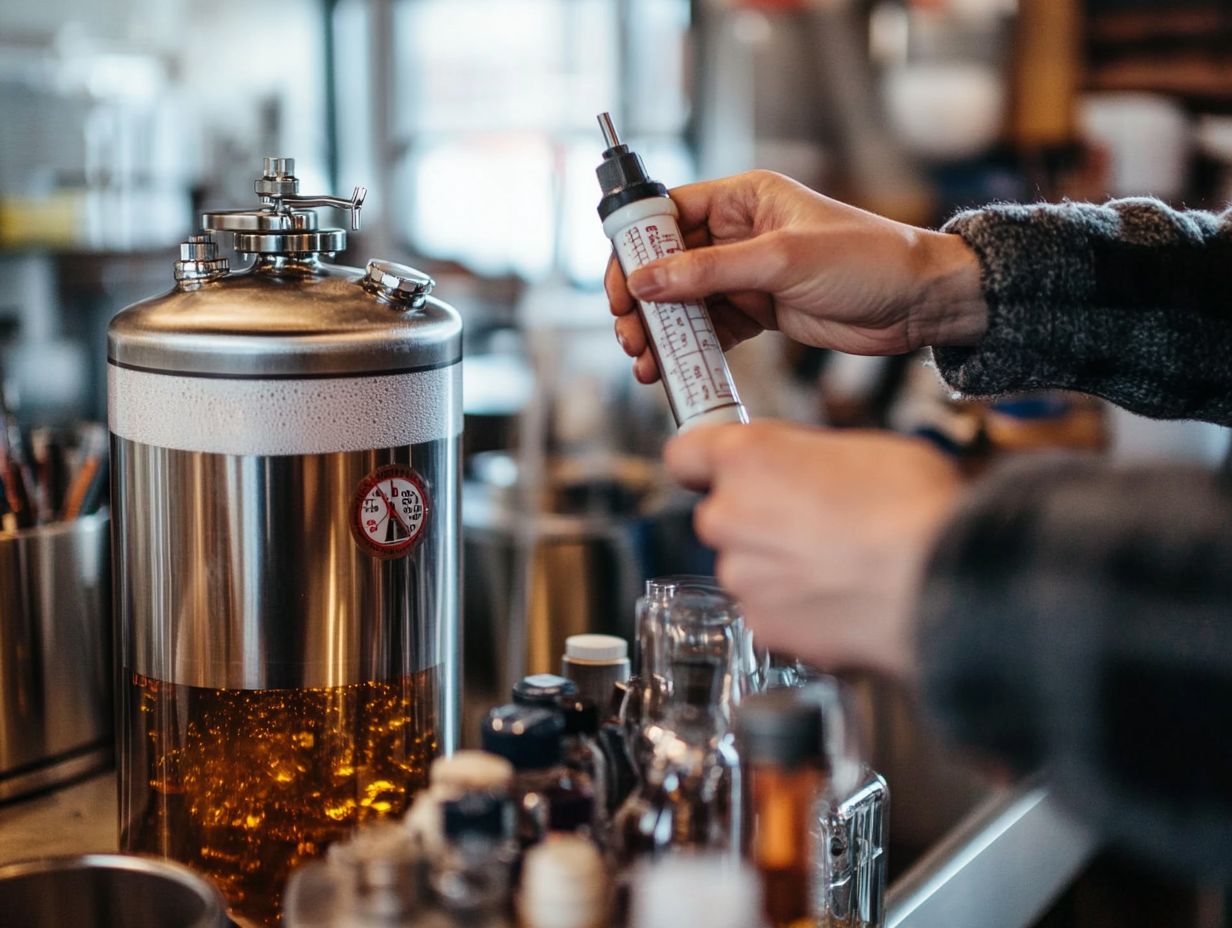
Leaks or clogs in your brewing equipment can drastically hinder your brewing efficiency and alter the wort gravity, resulting in inconsistent fermentation and disappointing carbonation levels. Maintaining your brewing water quality is also critical to prevent these issues.
These problems often stem from familiar offenders like damaged seals, loose fittings, or even debris accumulating in hoses and lines.
When your brewing equipment isn t properly maintained, it exposes your precious wort to unwanted air. This not only disrupts fermentation but can also distort your wort gravity readings. Such inconsistency can lead to a finished product that strays from the intended flavor profile and aromatic qualities you aspire to achieve.
Effective wort cooling techniques can help mitigate exposure to unwanted air.
As a dedicated homebrewer striving for optimal results, it s essential to meticulously check and address these potential pitfalls. This attention to detail ensures that each batch aligns with your desired specifications, allowing you to preserve the delicate balance of art and science that is brewing. Consider using brewing salts to fine-tune your water chemistry and achieve desired brewing goals.
Troubleshooting Tips for Home Brewing Equipment
When you encounter issues with your home brewing equipment, employing effective troubleshooting tips can significantly elevate your brewing experience and lead to a successful outcome. Addressing fermentation issues and maintaining beer clarity are crucial aspects to focus on.
From tackling sanitation concerns to ensuring optimal fermentation temperatures, there are several key strategies you can implement to enhance your brewing process. You must understand how to monitor and control various aspects of your equipment to steer clear of common pitfalls and achieve your brewing aspirations, such as managing original gravity and hop character.
By adhering to established brewing guidelines and employing proper brewing techniques, you can troubleshoot effectively and preserve the integrity of your homebrew.
1. Properly Sanitize Equipment
To prevent contamination, it s essential to properly sanitize all your brewing equipment using effective sanitizers before each brewing session. This critical step not only preserves the desired flavor and quality of your brew but also enhances yeast performance during fermentation.
Implementing bottle conditioning techniques can further ensure the quality of your final product.
- Begin by thoroughly cleaning all your equipment with a mild detergent to remove any visible residues.
- Afterward, rinse everything with hot water to eliminate any soap remnants.
- Next, select a suitable sanitizer options like Star San or Iodophor are highly regarded among brewers for their effectiveness and user-friendly nature. Some brewers also prefer using Blichmann or Micet Craft products for their advanced features.
- Dilute the sanitizer according to the manufacturer s instructions, ensuring that every surface comes into contact with the solution.
- Allow your equipment to air dry completely before using it.
By following these practices, you ll create a brewing environment that is safeguarded against unwanted microorganisms. This ultimately fosters healthier yeast activity and leads to a more successful fermentation process. Utilizing advanced brewing systems like TIANTAI BrewTech can further optimize your results.
2. Monitor and Control Temperature
Maintaining a consistent fermentation temperature is absolutely essential for your homebrew’s success. Using monitoring tools can be a game-changer in tracking those pesky temperature fluctuations.
Understanding the role of beta acids, which are a component in hops that affects bitterness, can also aid in achieving the desired flavor compounds.
These tools, ranging from simple thermometer strips to sophisticated digital systems that provide real-time alerts, are invaluable in ensuring that the yeast stays within its optimal temperature range. When you achieve precise temperature control, it profoundly impacts the fermentation process, shaping the flavor profile, clarity, and overall quality of your final product.
Employ methods like temperature-controlled fermentation chambers or insulating wraps to create an ideal environment for yeast activity. This effectively prevents issues such as stalled fermentation or unwelcome off-flavors.
By skillfully regulating the fermentation environment, you can elevate the taste and aroma of your beer, enhancing your brewing experience and delighting your palate. Utilizing brewing efficiency techniques and proper fermentation strains can further refine your process.
3. Use High-Quality Ingredients
Selecting high-quality ingredients, such as premium malt and hops, can significantly elevate the flavor and overall quality of your homebrew. Ensuring your brewing water is optimal plays a critical role in achieving these results.
The choice of these essential components enhances your sensory experience and adds complexity to various beer styles. For instance, using specialty malts can impart unique caramel, chocolate, or nutty notes elements crucial for robust styles like stouts or porters.
Likewise, opting for fresh hops can introduce vibrant floral or citrus aromas, truly elevating lighter ales and IPAs. Understanding astringency and how to avoid it is also important for perfecting your beer recipe.
By thoughtfully sourcing these ingredients from trusted suppliers, you can ensure that your creations have depth, character, and yeast performance. This ultimately captures the discerning palate of craft beer enthusiasts who appreciate various beer styles.
4. Check for Leaks or Clogs
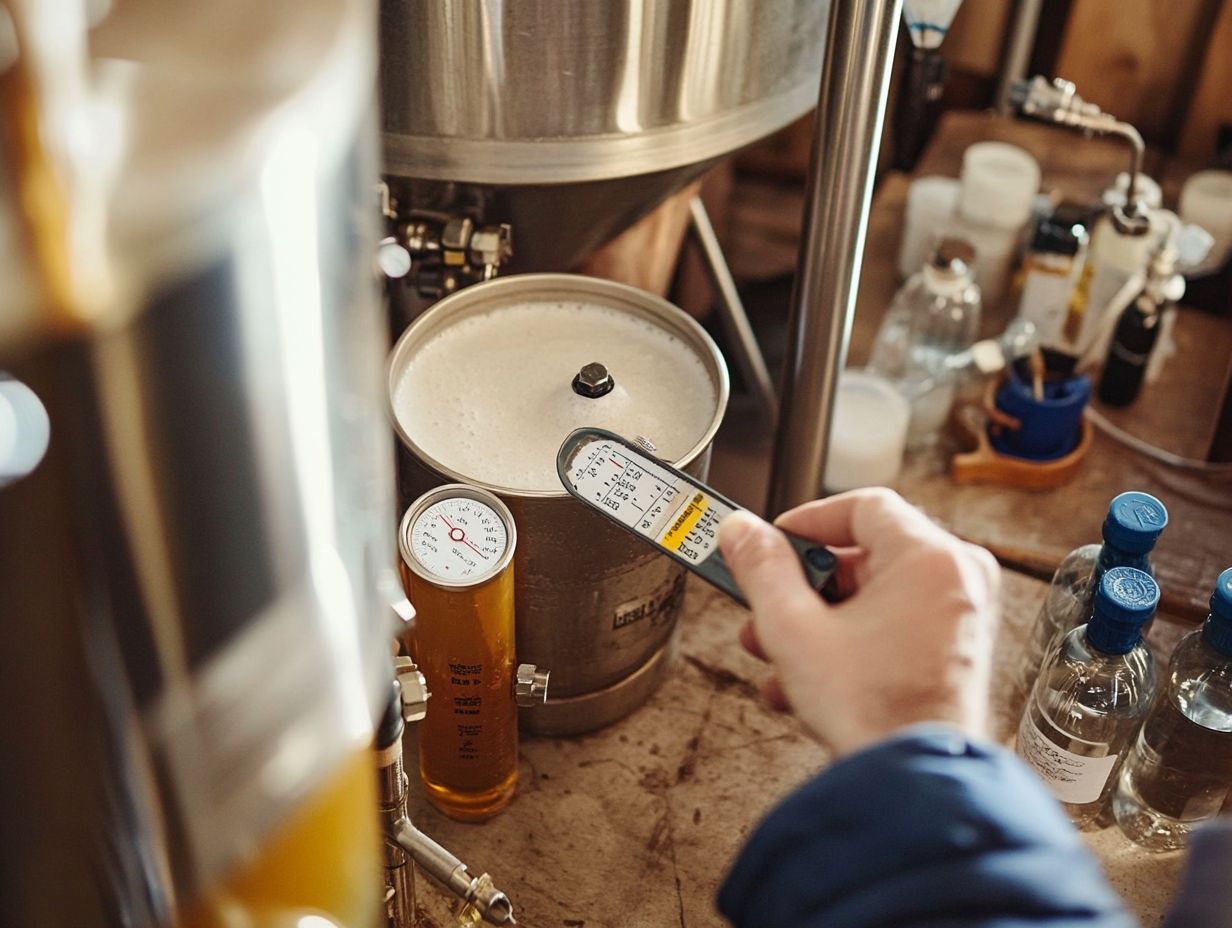
Regularly inspecting your brewing equipment for leaks or clogs is essential to prevent significant issues and maintain optimal brewing efficiency. These checks are crucial for preserving the quality of your brew and ensuring the longevity of your equipment.
A simple inspection can often expose minor leaks or blockages that, if ignored, could escalate into more serious problems. To identify these issues, start by visually assessing all connections, pH levels, and hoses for signs of moisture or wear.
Running water through the system is a great way to detect clogs. If you discover any leaks or blockages, promptly repairing or replacing the affected components will safeguard your brewing process and boost your overall productivity.
Get ready to elevate your brewing game! Start brewing today with these essential tips for a perfect homebrew!
How to Prevent Issues with Home Brewing Equipment
To prevent issues with your home brewing equipment and brewing water, it’s essential to engage in regular maintenance and troubleshooting and adhere to exemplary brewing techniques and brewing guidelines. By incorporating routine checks and following proper brewing practices, you can effectively mitigate common problems related to equipment failures and common mistakes. This includes addressing fermentation issues and ensuring consistent beer quality.
Understanding water chemistry and the role of brewing salts and carbonation will dramatically enhance your homebrew quality, transforming your brewing experience into something truly exceptional.
1. Regularly Clean and Sanitize Equipment
Regularly cleaning and sanitizing your brewing equipment is crucial to prevent the buildup of bacteria and flavor compounds that could spoil your homebrew. A well-maintained brewing setup is fundamental not just for hygiene; it s also key for achieving exquisite flavors and hop character in your beer.
If you neglect proper cleaning, residues from previous batches can introduce off-flavors and compromise the fermentation process. The integrity of each ingredient hangs in the balance.
To keep everything in pristine condition, consider investing in high-quality cleaning agents specifically designed for brewing, such as:
- Unscented dish soap – Effective for general cleaning.
- PBW (Powdered Brewery Wash) – A powerful cleaner that removes residues.
- Star San sanitizer – An excellent option for sanitizing surfaces.
Routine maintenance, including soaking and scrubbing components, is vital for ensuring the longevity and brewing success of your equipment while enhancing the overall quality of your final product.
2. Monitor Temperature Control
Regularly monitoring fermentation temperatures with precise tools enables you to ensure that your homebrew is fermenting under optimal conditions. This step is essential for achieving the desired flavor profile and preventing potential fermentation issues caused by temperature fluctuations.
For example, using digital thermometers or thermowells allows you to capture real-time temperature readings, enabling you to make timely adjustments as needed. Incorporating temperature controllers and fermentation jackets can elevate the stability of your brewing environment even further.
By adopting effective methods and tools for temperature monitoring, you can significantly reduce the risks associated with off-flavors and stuck fermentation, ultimately enhancing your overall homebrewing experience.
3. Purchase Quality Ingredients
Investing in high-quality brewing supplies, such as premium grains, yeast, and yeast nutrients, can elevate the consistency and overall flavor of your beer. When you prioritize top-notch ingredients, you re not just enhancing taste; you re also optimizing critical brewing metrics.
For example, choosing the right type of malt can boost extract efficiency and original gravity, leading to a more robust final product. This ensures your grain bed filters well during sparging.
Utilizing high-quality yeast strains grants you better fermentation control, resulting in a cleaner and more predictable flavor profile. This meticulous selection of ingredients ultimately paves the way for a more reliable brewing process, allowing both novice brewers and seasoned BJCP enthusiasts to achieve their desired outcomes.
Follow these steps to ensure your homebrewing journey is successful and rewarding!
4. Regularly Inspect Equipment for Leaks or Damage
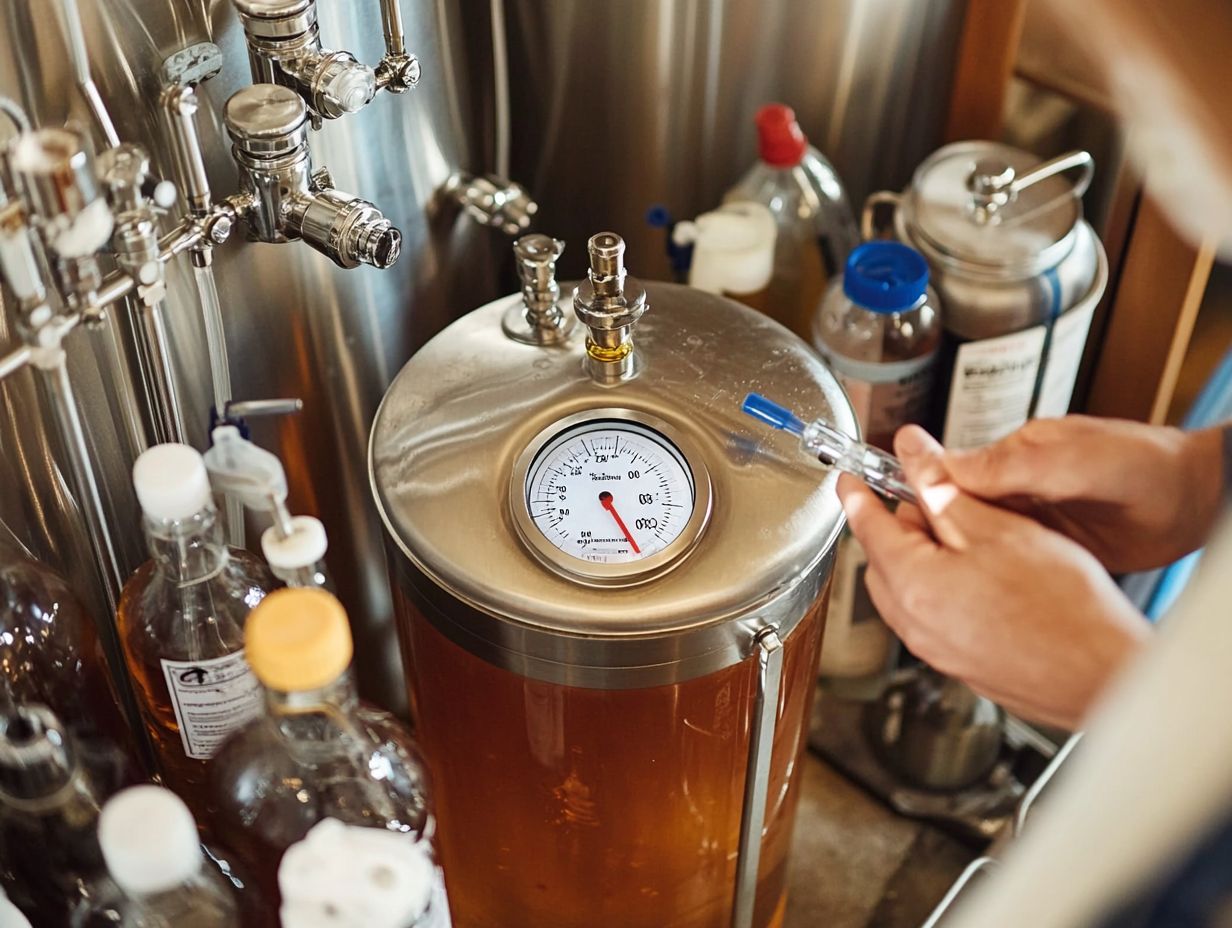
Regularly inspecting your brewing equipment for leaks or damage is essential for maintaining efficiency and extending the lifespan of your tools. By routinely checking for wear and tear, as well as any unusual bitterness in your brew, you can spot potential issues before they escalate, ensuring that your systems operate at their best.
Key practices include examining seals, hoses, and connectors for any signs of dimethyl sulfide (DMS) and checking for any signs of moisture build-up, which may indicate leaks. It’s also crucial to inspect the integrity of tanks and valves for any build-up of beta acids. Any corrosion or unusual wear can jeopardize the quality of your brew.
Keeping a clean environment free of astringency around your equipment will help in spotting problems early. Establishing a consistent maintenance schedule to ensure clear beer clarity not only enhances performance but also brings peace of mind, allowing you to focus on crafting exceptional beverages!
Frequently Asked Questions
Here are some common questions related to troubleshooting home brewing equipment:
How do I troubleshoot my home brewing equipment if it’s not working?
If your home brewing equipment isn’t working, start by checking your connections and ensuring everything is securely fastened. Then, check your power source to make sure it is functioning correctly. If those steps don’t solve the problem, consult your equipment’s manual for specific troubleshooting instructions or reach out to the manufacturer for assistance.
Why is my home brewing equipment not heating up?
If your home brewing equipment is not heating up, the most common cause is a faulty heating element. Check the heating element for any signs of damage or wear. If it looks damaged, it may need to be replaced. Also, ensure the temperature settings on your equipment are set correctly.
What should I do if my home brewing equipment is leaking?
If you notice that your home brewing equipment is leaking, the first step is to identify where the leak is originating. Check all hoses, connections, and fittings for any signs of damage or looseness. Tighten any loose connections or replace damaged parts as needed. If the leak persists, contact the manufacturer for further assistance.
Why is my brew not fermenting properly?
If your brew is not fermenting as it should, there could be several reasons. First, check the temperature of your brew and ensure it is within the recommended range for the yeast you are using. If the temperature is too low, the yeast may not be active enough to ferment properly. Also, check the quality of your yeast to confirm it is not expired or contaminated.
What should I do if my brew has an off-flavor?
If your brew has an off-flavor, the first step is to identify the cause. It could be due to contamination, improper brewing techniques, or expired ingredients. Once you identify the cause, take steps to fix the issue, such as thoroughly cleaning and sanitizing your equipment or adjusting your brewing process.
How can I prevent common issues with my home brewing equipment?
To prevent common issues with your home brewing equipment, it’s important to maintain and clean your equipment regularly. This includes replacing any worn or damaged parts and following proper cleaning and sanitation protocols. Additionally, carefully follow brewing instructions and use quality ingredients to ensure the best possible outcome for your brew.
Share your troubleshooting tips in the comments below!

